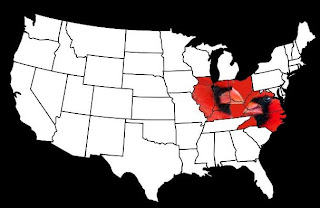 |
| By Bear Golden Retriever via Wikimedia Commons |
Many birds considered common New England residents are in fact relative newcomers. In recent decades species such as the Turkey Vulture, Red-bellied woodpecker, and Carolina Wren once uncommon in New England are now found here year round, exceptions being very harsh winters. Go back four or five decades and seasoned bird watchers (enter appropriate age here) remember a time when such New England staples as the Tufted Titmouse and the Northern Cardinal were rare New England visitors. An excerpt from A. C. Bent’s Life Histories of Familiar North American Birds published in 1968 recounts, Less scientific data tells a similar story. Consider this U.S. map showing the seven states who's official state bird is the Northern Cardinal: Illinois, Indiana, Ohio, Kentucky, West Virginia, Virginia, and North Carolina.
“As we travel southward from New England's ice and snow to meet spring halfway, we are greeted by the loud peto, peto of the tufted titmouse, the lively, striking song of the Carolina wren, and the rich, whistling notes of the cardinal redbird, three birds we rarely see in New England. They seem to be welcoming us to the land of sunshine and flowers, and their music brings a heart-warming change from the bleak and silent woods we have left behind. We formerly considered the cardinal a southern bird… our 1886 Check-List gave its range as only casual north of the valley of the Ohio River, which forms the northern boundary of Kentucky.” Text by Arthur Cleveland Bent and Collaborators. Selected and edited by Patricia Query Newforth
The state bird program began in 1927 and these original “red states” selected the bright songster between the years of 1928-1950, giving an informal picture of bird population and the physic power a bird can play in the identity of a region.
Since the cardinal was not a common northerly occurrence, New England states selected such hardy Yankees as the Black-capped Chickadee (Massachusetts and Maine), the Purple Finch (New Hampshire), and the American Robin (balmy Connecticut). Vermont in an act of optimism selected the summer residing Hermit Thrush and the State of Rhode Island and Providence Plantations, with what can only be described as a good sense of humor, selected the Rhode Island Red Chicken.
The cardinal's slow shift north over the past fifty years can be attributed to such factors as a rise in backyard bird feeding, their comfort nesting in sprawling suburban habitat, and even adaptation. Today the cardinal is a favorite backyard bird throughout New England, but don’t take this elegant songster for granted it is a new and welcome emigrant.
Cardinals and their large seed-cracking beaks will readily visit backyard feeders filled with sunflower or millet. For more information on attracting cardinals to your backyard visit the great resource from WorldBirds.org, "12 Simple Tips to Attract Cardinals to Your Backyard".
Cardinals and their large seed-cracking beaks will readily visit backyard feeders filled with sunflower or millet. For more information on attracting cardinals to your backyard visit the great resource from WorldBirds.org, "12 Simple Tips to Attract Cardinals to Your Backyard".



No comments:
Post a Comment